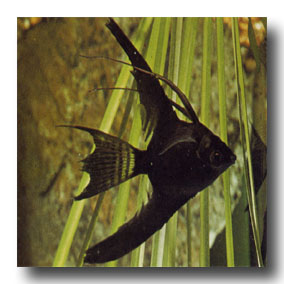Breeding Angelfish
By Barbie - fishaholics.org
Monday, August 19, 2002 12:36:00 PM
Email this article to a friend
Printer friendly page
Pterophyllum Scalare are relatively easy to breed, once you have established that you do indeed have a pair. There is no surefire method of sexing these fish by looking at them, so you have to wait for them to decide on the mate of their choice. They prefer soft, acidic water, but they are successfully kept and bred in an extremely varied array of water conditions. The main thing to keep an eye on is water quality.
In preparation for spawning, I use 6 inch clay pots that I buy from garden supply stores (never, EVER use pots that have been used previously for anything except the aquarium hobby). I soak them overnight in a bucket of water and then I simply set them in the 20 gallon breeder tanks with each pair. I keep sponge filters in each bare bottom tank. 20 gallons seems to give them enough room to raise the fry to an age of a week or more, without the possibility of the fry being stunted. I do water changes every other day, and I feed the adults twice a day on my Discus beefheart mixture that is high in protein and vitamins to help condition them for constant spawning. The parents will pick and clean a site, making practice runs over the surface for as much as a day or two sometimes before the actual spawning begins. When the males pointed genital papilla is evident (as opposed to the females bluntly rounded ovipositor) spawning is imminent, usually within two hours.
The shells on the eggs don't harden as quickly in softer water with a lower ph, so the male should be able to fertilize more of the eggs properly, insuring a better hatchout rate. I myself have found that I have a much better fertilization percentage using my RO water, but I was getting plenty of live fry without it too. The eggs are laid in bunches, and they should begin hatching between 48 and 72 hours. The warmer the water, the faster the eggs hatch, I normally keep my water at 82 degrees. Make sure you do no water changes during this time, because the eggs are extremely fragile and cannot tolerate the fluctuation of the ph and temperature. The eggs start to show tails wiggling first, and then either fall to the bottom and wiggle there as they absorb their yolk sack, or are placed back on the substrate somewhere by the parents.
Be ready to feed them live freshly hatched baby brine shrimp as soon as they rise to swim, mine rise in the water on the fifth day. I feed them 4 times a day, and I change water once a day, siphoning it into a bucket, and carefully letting everything settle so that I can make sure to not dump out the fry. I remove the fry from the parent tank at a week old, so as not to interrupt the breeding cycle. If the eggs are artificially hatched a pair of angels can reasonably spawn every 9 days, but I prefer to let the fry stay with their parents for a week, because I enjoy watching the interaction and because it is more convenient for me.
The babies are fed live freshly hatched brine shrimp until approximately a month of age. If your brine shrimp is more than two days old it has used up most of its nutritional value in forming its shell, and that shell is not digestible to the fish. Its really important to keep this in mind and keep hatching small new batches of brine shrimp rather than just using larger quantities. The amino acids that the brine shrimp contain are necessary for proper growth during that critical early stage of development. They will also pick at rotifers and such that can be found in a sponge filter that exists in a well-cycled tank.
To move angel fry I do not personally net them, but instead siphon them out into a bucket to prevent damage to their spines. They need to be moved into the water from their parent tank anyway and it's a very simple process that way. Then I just slowly pour the water from the bucket into the half-full tank that I have prepared to receive them. I get a lot of enjoyment out of raising the angels because of the parental care, but it is relatively easy to artificially hatch the eggs also. I feel that's just a matter of personal preference.
I hope you enjoy your attempts at learning about breeding angels as much as I did. If you need help feel free to email me at barbie@fishaholics.org , and if I am not able to answer your questions I might at least be able to pass it on to someone that will.
Provided courtesy of Barbie @ http://www.fishaholics.org© Copyright 2002 by Fishaholics.org
For more information on fish and aquaria click here
Copyright © 2006 design by Micki Sims

